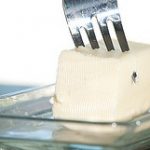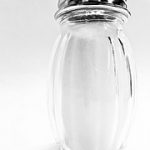It’s Q&A Thursday! This week, we’re taking a look at stainless steel cookware. Stainless is supposed to be one of the best and safest forms of cookware, but as I’ve said before, quality matters. So how do you know if one type of stainless steel is better than another? Is there a way to test stainless steel for quality?
Let’s find out!
Question of the Week
Martha asks:
Hi Emily! I was reading your article about cookware. Last year I bought a set of stainless steel pans. How do I know if they are good quality?… They are Pampered Chef and according to the information they are top quality. I try with a magnet and it will stick all over the pan just not inside… How can I make sure they are safe to cook? I’m totally changing my non-stick for more stainless or cast iron. Thank you for all your info. I cook a lot with butter… I love it!
This is a topic that a lot of people seem to be unsure about—I know I definitely was for quite a while! You hear so many different things about stainless steel. Some say it’s totally safe and non-reactive. Some say it leaches dangerous heavy metals into your food. Some say it’s the best thing ever and the only cookware you should use. Some say it’s only safe if it’s magnetic steel, which it sounds like you’ve heard before. You might have even heard it from me—that’s what I thought was the best way to test for quality, too! I’ve since learned some more information that might help you out.
So, let’s start with that whole magnetic thing. This is a confusing topic!
What’s the deal with magnetic stainless steel?
The theory of the “magnet test,” is sort of this rumor going around in which you’re supposed to test the quality of the stainless steel with a magnet. But really what this tests for, is whether or not the steel is austenitic, or made of a metal alloy which contains chromium and nickel.
There are three main types of structures in stainless steel—austenite, ferrite, and martensite. When you see stainless steel labeled as 18/8 or 18/10 this is telling you how much chromium and nickel is in the steel. The first number indicates 18% chromium, and the second 8% or 10% nickel. The nickel is the key to forming austenite stainless steel. Both the 18/8 and 18/10 are therefore austenitic.
So the “magnet test” is to take a magnet to your stainless steel cookware, and if it sticks, it’s “safe”—indicating no nickel present—but if it doesn’t stick, then it’s not safe, and contains nickel (which is an austenite steel). It is true that if a magnet were to stick to the steel, that it would not be a nickel (austenite) alloy.
There’s a problem with this theory, however. For one thing, there are no stainless steel pans which are magnetic on both the outside AND the inside. Not even All-Clad! Someone please correct me if I’m wrong, but I have searched and searched and searched, and have yet to come across a fully-magnetic piece of stainless steel cookware.
And there is a good reason for this—austenitic, or nickel-containing, non-magnetic stainless steel, is highly resistant to corrosion, which is super important if you’re cooking directly on it. If the piece was fully magnetic stainless steel, it would corrode and not last very long without the nickel to stabilize the metal. Even though it would be nickel-free, I don’t think I would even want a magnetic, 18/0 stainless steel pan for this reason!
You will find magnetic stainless steel in the layer on the outside of some quality pieces of stainless steel. This is to make it compatible with induction stovetops, which involve the use of a rapidly charging electromagnetic field to heat cookware. High-quality stainless steel, like All-Clad, uses three layers of metal—the austenite layer of steel on the inside, ferrite steel on the outside, and a layer of aluminum sandwiched between the two for optimal heat conductivity (steel alone does not conduct heat evenly). Lesser-quality stainless steel is usually just one layer of austenitic stainless steel.
But there is still a difference in quality between the types of austenitic, or non-magnetic, stainless steel. You’ll sometimes find that austenitic stainless steel is weakly magnetized, and that’s because of the manufacturing process. You can actually form ferrite and martensite by “cold-working” the steel, which does make it more prone to corrosion and leaching.
The formulation of austenite in high-end, quality stainless steel cookware is created with a process which is careful to avoid this. It leads to an austenite alloy which is very stable and resistant to corrosion and leaching of metals. I’m no metallurgist, but in my opinion, a carefully-formed and highly-stable, non-corrosive, nickel-containing stainless steel is safer than a purely magnetic stainless steel which could break down and corrode over time. (And which doesn’t even exist on the market, anyway!)
If you know anyone who has had good quality stainless steel cookware for a number of years, you can tell just by looking at it compared with cheap stainless steel, that it is indeed very resistant to corrosion and holds up well over time.
But, to answer your original question, Martha…
How do you know if your stainless is high quality?
Well, unless you’re a metals expert and go inspect the factory where the steel is made to see whether or not their manufacturing process creates a pure austenite without corrosive materials formed, you’re not going to know for sure whether or not the craftsmanship of your stainless is of the highest quality. I think your best bet is to simply buy high-quality stainless steel from the start, from a brand with a reputation for good quality. But, I think I have figured out one way that you can determine if the stainless cookware you already have is potentially reactive.
The Vinegar Test
I read that you can test the quality (or more accurately, the reactivity) of the steel by boiling some water with a tablespoon of baking soda in the pan for a few minutes. If the water has a metallic taste, then the steel is reactive and of lesser-quality.
But from what I’ve learned about stainless steel, my understanding was that it’s the acidic foods you have to worry about, when it comes to any leaching from stainless steel. And baking soda is alkaline. So, I decided to do a little science experiment and try a different test!
Here’s what I did:
I poured a couple tablespoons of plain white vinegar (which is of course, quite acidic) into two pots—my All-Clad 2-quart saucepan, and another generic stainless steel pan I had lying around. I also put some of the vinegar into a glass cup as a control.
After a few minutes, I taste-tested the vinegar from each.The All-Clad vinegar? Tasted exactly like the vinegar in the glass cup. But the vinegar in the cheap, generic stainless pan tasted like metal. Blech. The taste is still in my mouth as I type!
I definitely will be sticking with the All-Clad for my stainless steel cookware, personally. And, I’m pretty convinced my vinegar test is a decent way to determine the reactivity of your stainless steel. Try it out on yours and see if it passes! But if it doesn’t, I wouldn’t freak out over this. Just be mindful about cooking with very acidic things like tomato-based sauces and stuff, and avoid storing these foods in your stainless steel.
What cookware should you choose?
Well, clearly I’m a fan of the All-Clad, but I do think there are other quality stainless steel products out there. For more of my recommendations for healthy, safe cookware, including stainless steel, check out this post:
How to Pick Out a Safe Set of Cookware for Less Money
Got a Question?
Send me a Facebook message, email, or comment below. I try to get to as many questions as I can, but it can take a while to sort through all of them. Thanks for your patience! -Emily






Very interesting … so I have a pan given to me as a gift that that I’ve always assumed was stainless steel due to it’s looks, feel, and behavior. I have been loving it: it has a heavy copper bottom which browns things very evenly along the entire usable surface of the pan, and somehow it has always proven to be the easiest thing to clean no matter how badly I char something to it (even more easily than well-seasoned cast iron, which is usually pretty easy). So while there are many other, unrelated reasons to think I’m a fool, loving this pan is not one of them.
Now here’s the odd part. It’s labeled “10/00″, which I just now learned can’t be stainless steel (at least technically” since stainless steel must contain a minimum 10.5% chromium.
I know you just “debunked” this test, but bear with me. It’s not magnetic. But I’m using a powerful magnet and can get the magnet to stick if I place iron on the other side of the pan; I figure if there were any layer of “almost-stainless-steel” that had 0% nickel (as the label implies) the magnet should stick.
So now I’m just confused: what is this pan made of? (And do I really care as long as it keeps acting the way it does?) Have you ever encountered a 10/0 (or 10/00, not sure if the double 0 means anything) rather than a 18/0 label on cookware?
It’s labeled “Martha Stewart Everyday” yet I can’t find it anywhere online–maybe a long-discontinued product?
So the magnet only sticks when you put iron on the other side?
I wonder what your pan is made of! I would think by the “10/00” that would indicate 10% chromium and 0 nickel content, but no, I don’t think I’ve ever come across anything like that. I’m really not a stainless steel expert, though! 🙂 I tried googling “10/00 steel”, to no avail. Maybe someone with more knowledge about this will comment!
Emily- If you had access to all the money and kitchen items you wanted, what would be the ideal pot to make tomato sauce in? I ‘m married to an Italian and make lots of sauce at one time. I want a nice pot to do so in….even if I will have to save up to buy it!
Good question! For me, that would probably be a Le Creuset French (dutch) oven. They’re cast iron and enamel-coated, which is completely nonreactive and will last for generations.
This is the 5.5 quart: http://amzn.to/16WgNEH
And 7.25 quart: http://amzn.to/12wVYgo
And then, they do make actual stock pots which are enamel-coated steel, and much cheaper than the cast iron. Sounds ideal, but the reviews are mixed. I think for sauces though, it would be fine. Here’s the 8 quart pot: http://amzn.to/YfZgUe
I have wondered how to figure out if my stainless steel was safe. Thanks for the tip, I’m going to give this test a try.
Is your ‘cheap’ one a Revere Ware?
I’m not sure. It’s my sister’s that I borrowed before we had a chance to unpack when we moved to our new house last month. The bottom is pretty worn so I can’t make out what the label says.
I will have to test my favorite IKEA stock pot today 🙂
Anybody know anything about the Kirkland Signature stainless steel cookware set? I’ve had my eye on it forever but don’t want to put a lot of money into something that isn’t worth it.
Just wanted to let you know about the Pampered Chef stainless pans – this is from our catalog: Tri-Ply Clad, a thick aluminum core between an interior layer of 18/10 stainless steel and an exterior layer of 18/0, for durability and faster, more even heating.
Hope that helps.
I have a set of cookware from Amway. I just test my pot and lid with a strong magnet. In the lid, neith side was magnetic. In the pot, both inside and outside were strongly magnetic. I think my mother has Lifetime pots and pans about 60 years old and they are also strongly magnet in and out….Very interesting.
Sorry about the spelling mistakes!
Have you heard of DeBuyer cookware? Magnet almost jumped out of my hand 🙂
I just purchased a planetbox lunchbox for my son, they seem like a pretty legit company, should I worry about the stainless steel lunchbox?! How can I test if that’s quality stainless steel
I have DeLongui Stainless Steel Pans, and they are magentic both in the outside and the inside (they are more magenitc on the outside, if that makes sense)
Yesterday I bought a ‘stainless steal’ saute pan, Main Stays, the Wal Mart brand. I tried your magnet test. The magnet did not stick to the outside or AT ALL and barley stuck to the to the inside.I knew it was too good to be true. I’ll be returning it tomorrow.
Yesterday I bought a ‘stainless steal’ saute pan, Main Stays, the Wal Mart brand. I tried your magnet test. The magnet did not stick to the outside or AT ALL and barley stuck to the to the inside.I knew it was too good to be true.
Seriously? We finally bought stainless steal and now it might not be good enough?! It seems like everyday I read that something else we have in our home may not be safe. This is exhausting…
There may be important factor missing…We have an 11 litre pot and an 8 litre pot…They both indicate 18/10 on the bottom but the 8 litre one has about a 1/8 thickness on the bottom…The 11 litre one has about 1/4 ” The thicker bottom extremely rarely burns at the bottom…The 1/8 one burns the sauce almost every time at the bottom…So the gage of the bottom must be extremely important when purchasing…Thanks
My post indicates 4:44 am not true it was 9:44 am
We are trying to avoid nickel in out cookware. In a recent article in ACS ChemWorx, it notes that Chromium and Nickel in stainless steel pots and pans, leaches into foods during cooking. This Butter Believer website conversations include a discussion about detecting nickel in stainless cookware using a magnet. I tried it on various pots, pans, lids, and teapots. The magnet sticks to some and not to others. It stuck to all sides of our SS sauce pans, but not to lids. I assumed this indicated that we had little or no nickel in our pots and pans, but you don’t have to look too deep to discover that this test is not valid. I discovered that the magnet does not prove the presence, or absence of nickel. If you are like us, trying to avoid nickel, you may want to research a bit more before buying new cookware. Best of luck. Jim
Hi Emily. I’m looking at a waring stainless steel blender pitcher/jar. Since I would mostly use this for cold food, would there be any risk of leaching? Also, would the high speeds generated during blending scratch the material causing any leaching? Thanks!
Hmm… good question! I wouldn’t sweat it, personally. Actually, I think I’d rather have plastic for a blender jar—glass could break, and the plastic wouldn’t worry me for the reason you mentioned (it’s unlikely to leach, due to short exposure and mostly cold temperatures). And whoa, is the stainless one really like $200? I just tried looking it up and that’s what I saw on Amazon. Yikes!
Consider Bisphenol-A, a chemical present in many plastics.
I use glass bottles and jars wrapped in duct tape. You can pick a pretty color these days, and then if you drop the container, there
won’t be pieces of glass all over the floor.
Good Luck!
Not sure how concerned I should be – but I have a 30 year old set of Revereware (back when that was an expensive brand) They seem to be non magnetic on the lids & smaller pots, but slightly magnetic on the larger pots & the vinegar doesn’t change flavor- so I will have to assume they are fine. I also have 2 Revereware stainless steel jelly roll pans that bake everything much better than any other bake ware I own. In fact the bake so well my 4 adult children all want me to leave these 2 pans to them in my will…lol Back to the jelly roll pans I have always said that the pan made in Hong Kong baked & cleaned up a bit better than the one made in Korea and feels ever so slightly heavier…today I did your magnet test & the Korean pan is non magnetic, but the Hong Kong pan is magnetic on both sides. Both of these pans are 16 years old, bought about 6 months a part. I am going to keep using them because I am guessing the damage is done…but I am still confused as to what do I own.
Actually I have an old Revereware pot from my mom. It IS magnetic inside and out. It isn’t corroded at all even though it must be over 40 years old and used all the time.
Thank you for posting! We are SUPER careful about what we eat and about two years ago I switched to ceramic double walled coffee mugs because the idea of acidic coffee in stainless gave me pause. Your posting was really detailed and informative and I linked to it on my most recent blog about coffee cups. Thanks again!
I received a gift set of Kenmore stainless steel with copper band 10+ years ago. They are magnetic inside, outside, on the side…the only thing not magnetic are the handles. Looking for a set of budget friendly SS pans for my daughter, and knowing she prob won’t want her mother’s set, opted for Cuisinart Chef’s Classic 11 pc set. Looked up tips for cooking with SS to print for her and ran across this article (& 2 similar articles). Checked her new set and NOTHING on it is magnetic. Find it hard to believe a brand as big as Cuisinart could be making/selling dangerous cookware and not be outed by now. So much ambiguity on this topic I’m not sure if I should return this set or not. ???? Suppose I’ll give it to her but inform her of controversy and we’ll both keep our eyes opened for when the jury is in on this one.
I’m using a Farberware Yosemite coffee percolator and I’ve heard stainless steel can release nickel. I was wondering if this brand has any problem with that. Thanks.
I wonder if the vinegar test will work on anything besides cookware. I mean, we use stainless steel for a lot of things. More specifically, my sink. However, I don’t really want to drink any vinegar from my sink. Are there other ways to test the quality of stainless steel that isn’t used for cooking?
“there are no stainless steel pans which are magnetic on both the outside AND the inside.”
Here in Thailand there is a brand of stainless steel cookware called
Seagull which is magnetic on the outside, the inside, the top and the bottom, on all surfaces. I am very pleased if that means that I am not ingesting nickel.
Another thing to consider is your dental crowns, which often contain nickel, even so-called “gold” crowns. The more you learn about these
things, the more there is to worry about, and most dentists will not inform you of this, and are not even aware of the fact that stainless steel contains nickel, or that nickel is highly toxic.
Your “gold” crowns are often less than 50% gold, and your “silver” fillings are 50% mercury, a heavy metal even more toxic than nickel.
Thank you Emily, The vinegar test was very helpful!
J